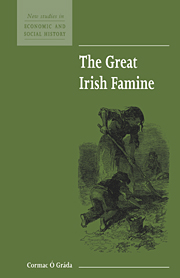Book contents
- Frontmatter
- Contents
- Preface
- Introduction
- 1 Population and potatoes: the pre-Famine context
- 2 The Great Hunger 1845–1850
- 3 Aftermath: Ireland after 1850
- 4 Conclusion
- Select bibliography
- Bibliographical update and commentary
- Glossary
- Index
- Titles available in the New Studies in Economic and Social History series
- Titles available in the Studies in Economic History series
- Economic History Society
3 - Aftermath: Ireland after 1850
Published online by Cambridge University Press: 05 June 2012
- Frontmatter
- Contents
- Preface
- Introduction
- 1 Population and potatoes: the pre-Famine context
- 2 The Great Hunger 1845–1850
- 3 Aftermath: Ireland after 1850
- 4 Conclusion
- Select bibliography
- Bibliographical update and commentary
- Glossary
- Index
- Titles available in the New Studies in Economic and Social History series
- Titles available in the Studies in Economic History series
- Economic History Society
Summary
like the Bolshevik Revolution in Russian history or the Great War in British, the Famine is the great divide in modern Irish economic and social history. Traditional historiography emphasized this watershed aspect: the Famine marked the end of ‘prehistoric times in Ireland’, and there followed a reaction by the people against everything linked to the pre-Famine era. An eminent folklorist's list of forsaken hallmarks ranges from wild fruit to early marriage, and from goats and donkeys to clustered human settlements (or clachans). More prosaically, pre-Famine Ireland has been associated with high population growth, low mobility, endemic violence, immiseration, high nuptiality; the Famine is supposed to have turned all this upside down. Yet it is now fashionable to stress the elements of continuity between pre-and post-Famine eras. According to Cullen, ‘the Famine was less a national disaster than a regional and social one … even if a famine had not interfered, a decline in population was inevitable’. The shift from tillage to cattle, long associated with post-Famine clearances and population loss, has been extended back to the 1810s by Crotty (1966, ch. 2), the decline in population to the early 1840s by Carney (1977). Even the correlation between Famine-induced population decline and the disappearance of clachans has been disputed. But perhaps this part of the recent trend to de-sensationalize the Famine has been overdone. In so far as economic and social history can be divided into stages or epochs at all, the Famine is a dividing line.
- Type
- Chapter
- Information
- The Great Irish Famine , pp. 57 - 67Publisher: Cambridge University PressPrint publication year: 1995



